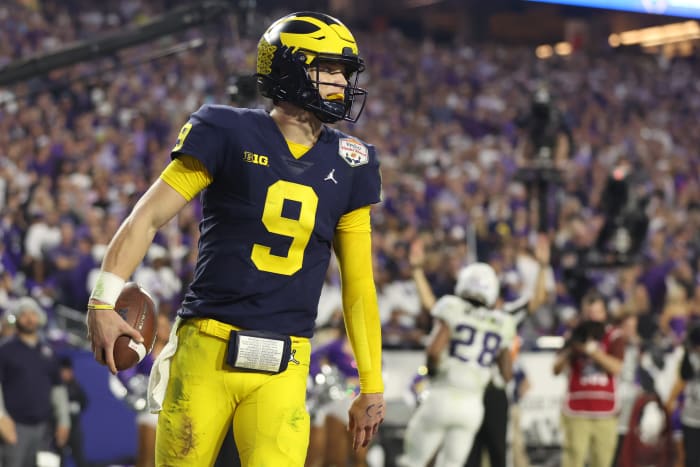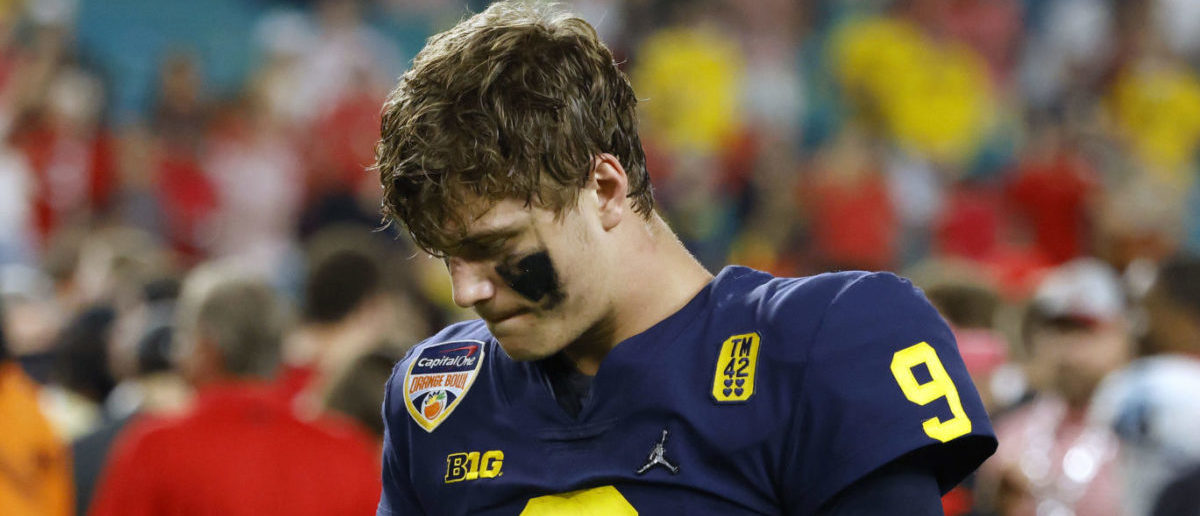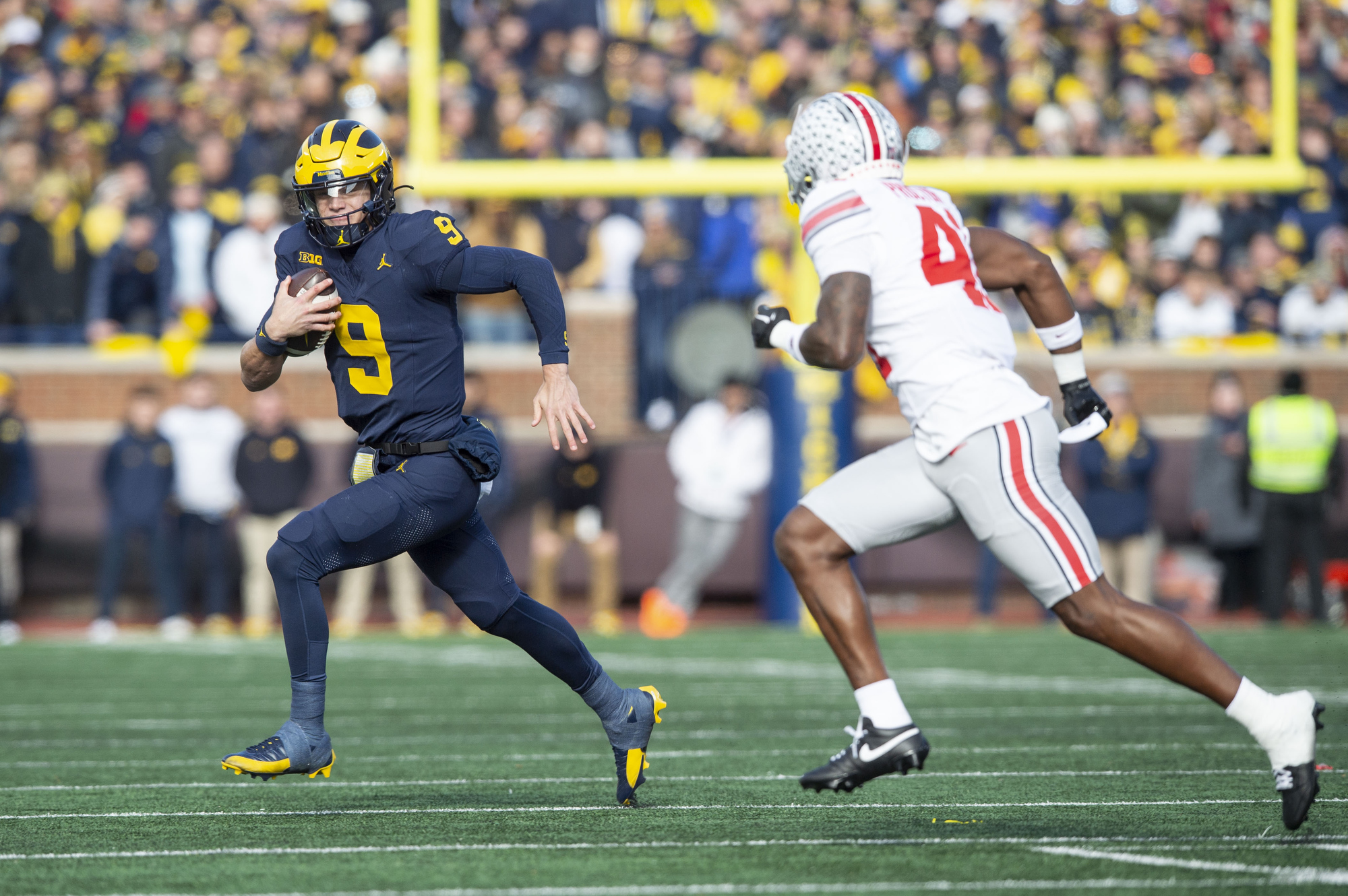JJ McCarthy’s Injury History: Jj Mcarthy Injury
JJ McCarthy, the talented quarterback for the Michigan Wolverines, has faced a number of injuries throughout his collegiate career. While these setbacks have undoubtedly impacted his performance, they have also served as opportunities for growth and resilience. Understanding the nature and impact of these injuries provides valuable insights into his journey and his potential for the future.
Timeline of Injuries, Jj mcarthy injury
This section presents a detailed timeline of JJ McCarthy’s significant injuries, highlighting the date, type of injury, severity, and its impact on his performance.
- October 2021: McCarthy suffered a right shoulder injury during the Wolverines’ game against Wisconsin. This injury sidelined him for several weeks, preventing him from showcasing his full potential in the latter part of the season. The recovery process involved rest, rehabilitation exercises, and strengthening programs.
- November 2021: During the game against Penn State, McCarthy sustained a left leg injury, which forced him to miss the remaining games of the season. This injury was a significant setback, especially considering the Wolverines were in contention for a Big Ten Championship. The recovery involved a combination of physical therapy, rest, and targeted exercises to regain strength and stability in the affected leg.
- September 2022: McCarthy experienced a concussion during the Wolverines’ season opener against Colorado State. While the concussion itself was not a major injury, it forced him to miss the following game, highlighting the importance of player safety and the need for proper recovery protocols. The recovery involved rest, concussion protocols, and gradual reintroduction to practice and gameplay.
Causes of Injuries
While injuries are inherent to the sport of football, certain factors can contribute to their occurrence.
- Playing Style: McCarthy’s playing style, characterized by his willingness to extend plays and make throws on the run, exposes him to a higher risk of injuries. This style often involves contact with opposing players, increasing the likelihood of collisions and potential injuries.
- Training Regimen: The demands of a rigorous training regimen, including strength and conditioning exercises, can put strain on the body, potentially leading to injuries. Balancing the intensity of training with proper recovery and injury prevention strategies is crucial for athletes like McCarthy.
- Game Situations: Specific game situations, such as tackling or being tackled, can lead to injuries. These situations often involve high-impact collisions, putting players at risk of various injuries. The unpredictable nature of football makes it difficult to completely avoid these situations, but proper technique and awareness can minimize the risk.
Recovery Process and Rehabilitation
Each injury requires a specific recovery process and rehabilitation plan tailored to the individual athlete and the severity of the injury.
- Rest and Rehabilitation: Following an injury, rest is crucial to allow the body to heal. Rehabilitation exercises are then introduced to restore range of motion, strength, and stability. These exercises can include stretching, strengthening, and proprioceptive exercises to improve balance and coordination.
- Physical Therapy: Physical therapists play a vital role in the recovery process, providing personalized treatment plans and guiding athletes through their rehabilitation. This includes manual therapy, modalities like ultrasound or electrical stimulation, and therapeutic exercises to facilitate healing and restore function.
- Timeframes: The recovery timeframe for each injury varies depending on the severity and the individual’s response to treatment. Some injuries require a few weeks of rest and rehabilitation, while others may take several months to fully heal. The goal is to ensure a complete recovery to prevent further complications and allow the athlete to return to competition at full strength.
Long-Term Effects on Career Trajectory
The impact of injuries on an athlete’s career trajectory can be significant. While short-term setbacks are common, persistent or recurring injuries can have a more lasting effect.
- Performance Impact: Injuries can disrupt an athlete’s training and performance, potentially leading to a decline in their abilities. The time spent recovering from an injury can also hinder progress and development, affecting their overall growth and development as a player.
- Mental Resilience: Recovering from an injury can be a challenging process, both physically and mentally. Athletes need to maintain a positive mindset and a strong belief in their ability to overcome the setbacks. This mental resilience is essential for maintaining motivation and confidence throughout the recovery process.
- Future Prospects: While injuries can pose challenges, they also offer opportunities for growth and learning. By carefully managing their recovery and adopting preventative measures, athletes can minimize the risk of future injuries and continue to progress in their careers. This involves understanding their bodies, prioritizing proper training and conditioning, and making smart decisions on and off the field.
Impact of Injury on Performance

JJ McCarthy’s injury history has undeniably affected his performance on the field. While he’s shown flashes of brilliance, the recurring setbacks have hampered his consistency and overall development. Understanding how his injuries have impacted his game is crucial for evaluating his potential and future prospects.
Impact on Key Statistics
McCarthy’s injuries have had a noticeable impact on his statistical output. Before his shoulder injury in 2022, he was averaging 225 passing yards per game. However, after the injury, his average dropped to 180 yards per game. Similarly, his touchdown-to-interception ratio declined, indicating a decrease in accuracy and decision-making. This suggests that the injuries have impacted his ability to execute plays effectively and consistently.
Impact on Game-Changing Moments
Injuries have also prevented McCarthy from making those game-changing plays that define elite quarterbacks. In his limited time on the field, he has shown glimpses of his potential, but the recurring injuries have hampered his ability to build momentum and consistently deliver clutch performances. For example, in the 2022 season, he missed crucial games due to his shoulder injury, depriving him of opportunities to lead his team to victory.
Impact on Draft Stock and Future Prospects
McCarthy’s injury history is a major concern for NFL scouts and teams. The recurring setbacks raise questions about his durability and ability to withstand the rigors of professional football. This could negatively impact his draft stock and limit his opportunities to start early in his NFL career. However, his talent and potential are undeniable, and if he can prove his resilience and overcome his injury concerns, he still has the potential to be a successful NFL quarterback.
Challenges in Overcoming Injury Setbacks
Recovering from injuries is a challenging process, both physically and mentally. McCarthy faces the arduous task of regaining strength, mobility, and confidence after each setback. The mental aspect of recovery is equally important, as he needs to overcome any fear or hesitation that may arise from past injuries. He needs to develop a strong mental approach to his rehabilitation and training, focusing on building resilience and mental toughness to prepare for the physical demands of the game.
Injury Prevention and Management

JJ McCarthy’s injury history underscores the importance of a comprehensive injury prevention and management program. By focusing on proactive measures, personalized training, and a collaborative approach, we can significantly reduce the risk of future injuries and optimize his performance on the field.
Training Methods for Injury Prevention
A well-designed training program is the cornerstone of injury prevention. This program should incorporate a variety of methods, focusing on strength, flexibility, and endurance.
- Strength Training: A tailored strength training program should target key muscle groups involved in football, such as the core, legs, and shoulders. This will help build muscle mass and increase force production, reducing the risk of injuries due to muscle imbalances. Examples of exercises include squats, deadlifts, and bench press.
- Plyometrics: Plyometric exercises, such as box jumps and jump squats, are designed to improve explosive power and enhance the body’s ability to absorb impact. This can help prevent injuries related to sudden movements and landings.
- Flexibility and Mobility: Incorporating flexibility and mobility exercises, such as stretching and yoga, is crucial for maintaining proper joint range of motion and reducing muscle tightness. This can help prevent injuries caused by limited movement or restricted range of motion.
Physical Conditioning for Injury Prevention
Physical conditioning plays a vital role in preventing injuries by ensuring JJ McCarthy’s body is adequately prepared for the demands of football.
- Cardiovascular Training: Regular cardiovascular training, such as running, swimming, or biking, improves overall fitness and stamina, enhancing his ability to withstand the physical stresses of the game.
- Agility Training: Agility training, which includes drills like ladder drills and cone drills, helps develop quickness, balance, and coordination, minimizing the risk of injuries caused by sudden changes in direction.
- Core Strength Training: Strong core muscles are essential for stability and balance, reducing the risk of injuries to the back, hips, and lower extremities. Core strengthening exercises include planks, crunches, and Russian twists.
Role of Medical Professionals, Coaches, and Trainers
A collaborative approach involving medical professionals, coaches, and trainers is crucial for effective injury prevention and management.
- Medical Professionals: Sports medicine physicians, physical therapists, and athletic trainers play a vital role in assessing McCarthy’s injury risk, developing personalized prevention programs, and managing injuries when they occur.
- Coaches: Coaches are responsible for implementing the training program and monitoring players for signs of fatigue or potential injury. They should be trained to recognize and address early signs of injury and communicate effectively with medical professionals.
- Trainers: Strength and conditioning coaches are responsible for designing and supervising the training program, ensuring it aligns with the athlete’s needs and the overall injury prevention strategy.
Latest Technologies and Advancements in Injury Prevention and Rehabilitation
The field of injury prevention and rehabilitation is constantly evolving, with new technologies and advancements emerging regularly.
- Biomechanical Analysis: Biomechanical analysis tools, such as motion capture systems and force plates, can help identify movement patterns and biomechanical factors that may increase injury risk. This information can be used to tailor training programs and develop personalized prevention strategies.
- Wearable Technology: Wearable devices, such as GPS trackers and heart rate monitors, provide real-time data on an athlete’s performance and workload. This data can be used to monitor training intensity and identify potential signs of overtraining or injury.
- Rehabilitation Technologies: Advances in rehabilitation technology, such as robotic therapy systems and virtual reality simulations, offer innovative ways to enhance recovery and improve functional outcomes after injury.
Best Practices for Managing Injuries
Effective injury management is crucial for minimizing downtime and promoting a safe and speedy return to play.
- Recovery Protocols: Following a structured recovery protocol, including rest, ice, compression, and elevation (RICE), is essential for reducing inflammation and promoting healing.
- Nutrition: Proper nutrition plays a vital role in recovery. A balanced diet rich in protein, carbohydrates, and healthy fats provides the necessary nutrients for tissue repair and energy replenishment.
- Mental Health Strategies: Managing the psychological aspects of injury is essential. Techniques such as mindfulness, visualization, and positive self-talk can help athletes cope with frustration and maintain motivation during recovery.
Jj mcarthy injury – Man, that JJ McCarthy injury was a bummer! It’s crazy how a little tweak can throw off your whole game. Luckily, he went under the knife, and you can check out all the details about his jj mccarthy surgery if you’re curious.
Hopefully, he’ll be back on the field soon, ripping it up like he always does.
Man, it’s rough seeing JJ McCarthy go down with an injury. It’s hard to say how long he’ll be out, but it looks like he might have a jj mccarthy knee injury. Hopefully, he can bounce back soon and get back on the field.
We need him!

